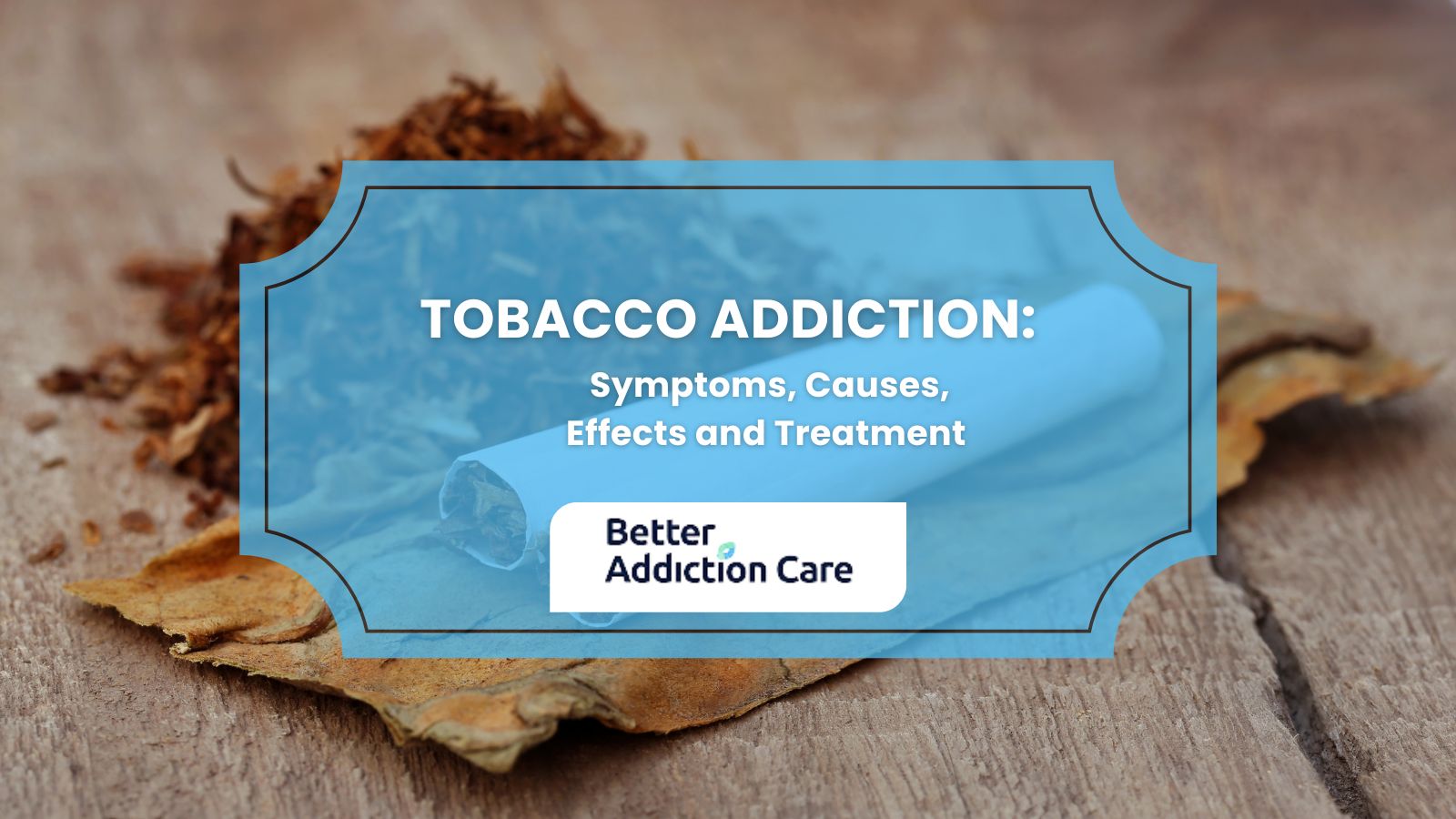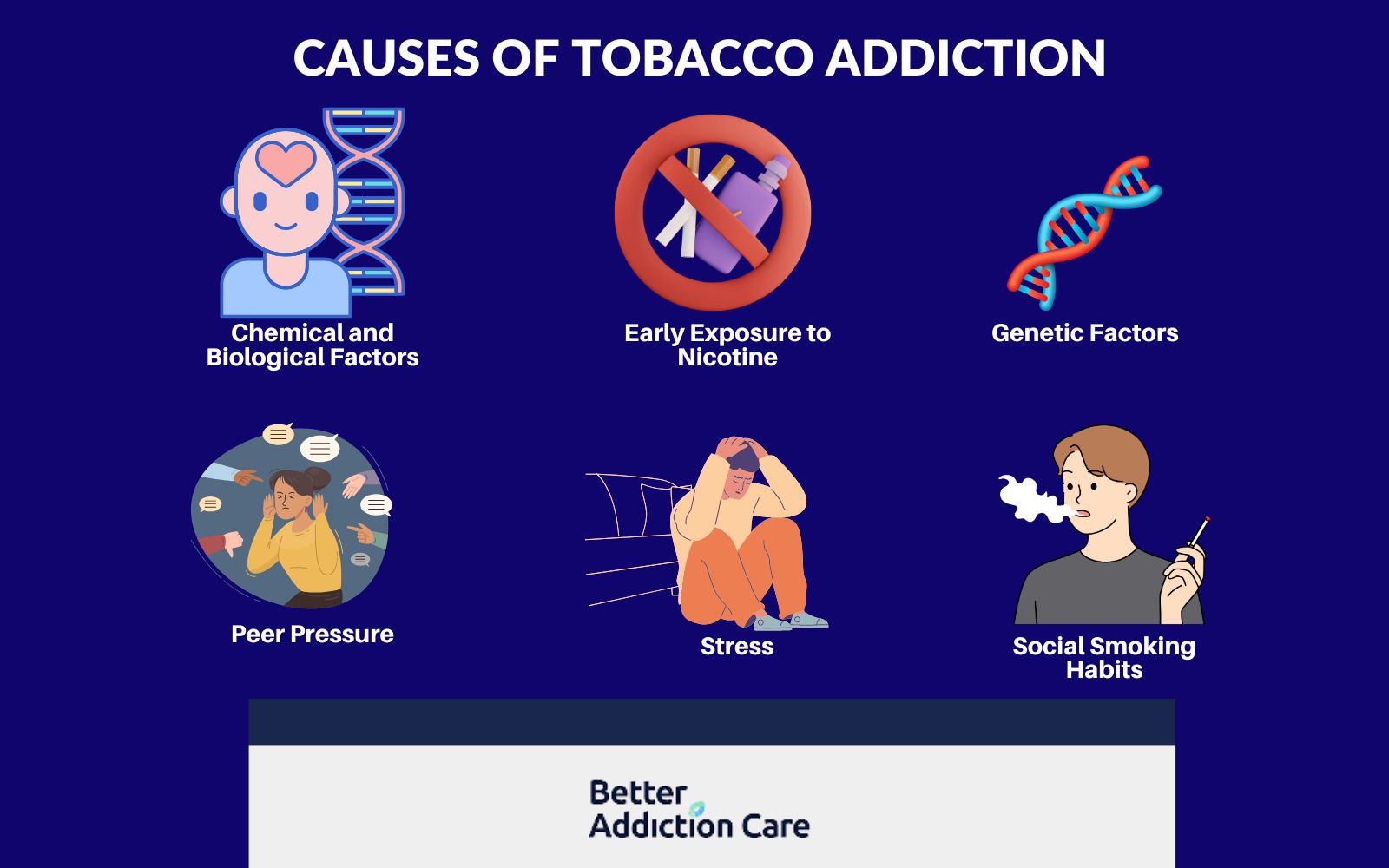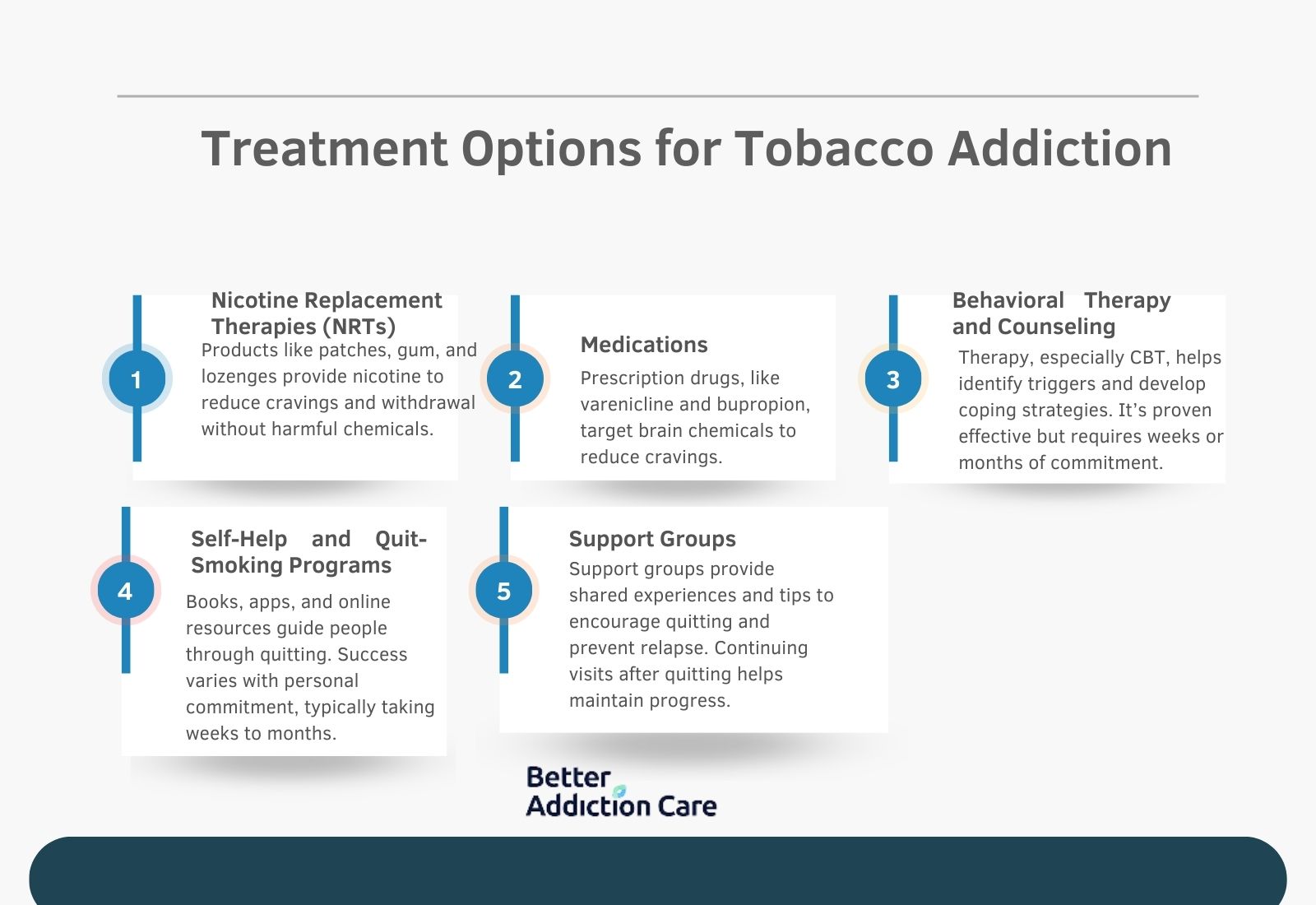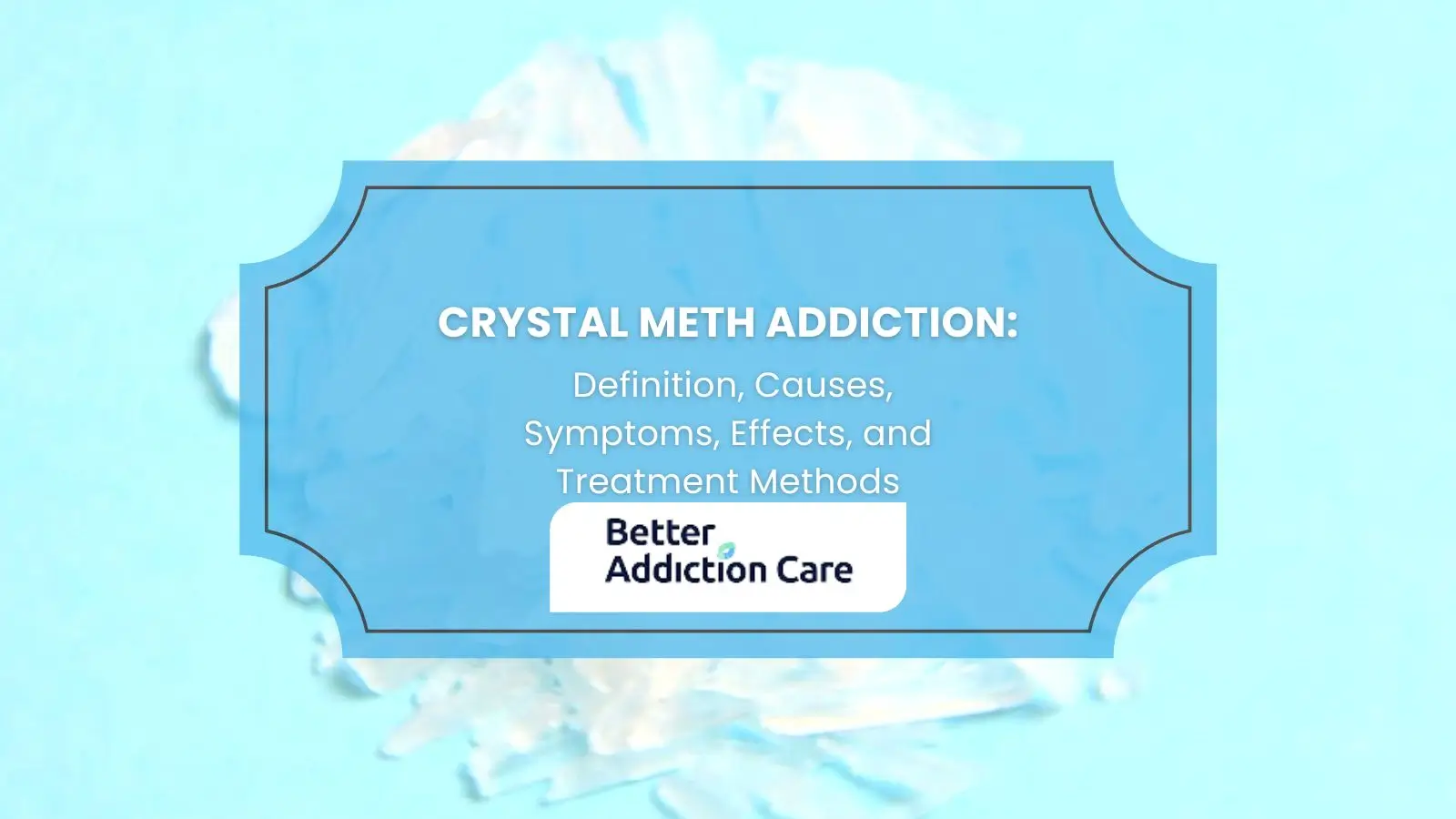Tobacco Addiction: Symptoms, Causes, Effects and Treatment
Tobacco addiction, or nicotine addiction or dependence, is a chronic condition where individuals have the compulsive need to use tobacco products despite the harmful effects and continuous efforts to stop.

Tobacco addiction, or nicotine addiction or dependence, is a chronic condition where individuals have the compulsive need to use tobacco products despite the harmful effects and continuous efforts to stop.
The key symptoms of tobacco addiction include strong cravings, increased tolerance, and withdrawal symptoms such as irritability and anxiety when not using tobacco. The main causes of tobacco addiction are chemical and biological factors, early exposure to nicotine, genetic factors, stress, and peer pressure.
Tobacco addiction leads to severe health effects, such as increased risks of heart disease, cancer of the lungs or throat, infertility, and weight loss. The treatment options for nicotine addiction involve nicotine replacement therapies (NRT) such as patches or gum, medications like varenicline, and behavioral therapies. Support groups and counseling can improve the chances of quitting too.
What is Tobacco Addiction?
Tobacco addiction is a chronic disorder that involves the compulsion to use tobacco products due to nicotine's highly addictive properties. Nicotine activates receptors in the brain and releases dopamine. This creates a cycle that leads to psychological and physical dependence.
The DSM-5 (Diagnostic and Statistical Manual of Mental Disorders, Fifth Edition) identifies tobacco use disorder with criteria including cravings, difficulty reducing usage, and withdrawal symptoms like anxiety and restlessness when nicotine intake is reduced.
Nicotine dependence or addiction is not just habitual but involves neurochemical changes that make cessation challenging even with a strong desire to quit, according to Neal L Benowitz in their research paper “Nicotine Addiction.” The high rate of dependency indicates why tobacco addiction is a critical public health concern.
How Does Nicotine Cause Addiction?
Nicotine causes addiction by affecting the brain’s chemistry which leads to physical and psychological dependence. Tobacco or nicotine quickly reaches the brain when it is inhaled or absorbed in the body and binds to nicotinic acetylcholine receptors, according to research published by the National Library of Medicine. This action triggers the release of neurotransmitters like dopamine, which creates feelings of pleasure and relaxation. The brain starts to rely on the dopamine release to feel normal which ultimately leads to dependence or addiction.
How is Tobacco Consumed?
Tobacco is consumed through smoking and chewing, each form differently delivering nicotine to the body. The most common method is smoking, which includes cigarettes, cigars, and pipes. Inhaling tobacco smoke allows nicotine to reach the brain within seconds and gives an immediate effect. Another popular method is chewing tobacco by placing shredded tobacco leaves between the cheek and gum. The chewing tobacco method allows nicotine to be absorbed through the mouth lining. There are smokeless options, too, such as inhaling tobacco powder or placing it under the lip. People, specifically youngsters, use electronic cigarettes or vapes. Electronic cigarettes and vapes are not similar to traditional tobacco products and deliver nicotine through vaporized liquid.
How Common is Tobacco Addiction?
Tobacco addiction is common because it affects millions of individuals in the United States. In 2022, approximately 49.2 million U.S. adults, about 19.8%, or nearly 1 in 5, reported current tobacco product use, according to the recent analysis of the National Health Interview Survey (NHIS) data from 2019 to 2022 by the CDC.
Among these adults, around 73.6% used combustible tobacco products, such as cigarettes and cigars. While overall tobacco use declined from 2019 to 2022, the use of e-cigarettes increased, with nearly 15 million adults reporting current e-cigarette use in 2022. The same report highlights that approximately 13 in 100 men currently smoke cigarettes compared to 10 in 100 women.
Tobacco product use remains the leading cause of preventable disease and death in the U.S., accounting for more than 480,000 deaths annually, according to the Centers for Disease Control and Prevention. Lung cancer is the most common consequence of tobacco addiction, and is responsible for approximately 154,000 deaths each year, while smoking is a leading cause of heart disease.
What are the Signs & Symptoms of Tobacco Addiction?

The signs and symptoms of tobacco addiction include strong cravings, increased tolerance, irritability or anxiety when not using tobacco, using tobacco to relieve stress, neglecting responsibilities, and failed attempts to quit.
These signs and symptoms are listed below.
-
Strong Cravings: Strong cravings refer to intense urges to smoke or use tobacco products. These cravings make it difficult to resist the temptation, even when they want to quit, according to the study “Associations between nicotine product use and craving among stable daily and non-daily users.”
-
Increased Tolerance: Tobacco addicts find themselves needing to consume larger amounts of tobacco to achieve the same pleasurable effects since they have built tolerance to smaller amounts.
-
Irritability or Anxiety When Not Using Tobacco: Addicts experience feelings of irritability and anxiety when they stop using tobacco, according to the study “Severity of negative mood and anxiety symptoms occurring during acute abstinence from tobacco: A systematic review and meta-analysis.”
-
Using Tobacco to Relieve Stress: Many individuals with personal, academic, or work-life problems turn to tobacco as a coping mechanism whenever they feel stressed. This behavior is a key sign of addiction.
-
Neglecting Responsibilities: Neglecting responsibilities refers to tobacco addicts prioritizing their need for nicotine over personal, professional, or social duties. They even get up from important meetings to smoke.
-
Failed Attempts to Quit: Individuals with addiction find it hard to quit despite having a strong desire to stop using tobacco. They get scared of withdrawal symptoms and cravings, which leads to repeated failed attempts.
What are the Causes of Tobacco Addiction?

The causes of tobacco addiction include chemical and biological factors, early exposure to nicotine, genetic factors, peer pressure, stress, and social smoking habits.
These causes of tobacco addiction are explained below.
-
Chemical and Biological Factors: Chemical and biological factors refer to the effects of nicotine on the brain and body. Nicotine is a strong stimulant that triggers the release of dopamine, a neurotransmitter that creates feelings of relaxation and pleasure. The brain adapts and gets used to the feeling, leading to more cravings for nicotine when not using tobacco, according to the study “Biological basis of tobacco addiction: Implications for smoking-cessation treatment.”
-
Early Exposure to Nicotine: Individuals who start smoking or using tobacco at a young age are more likely to develop a stronger addiction. Early exposure alters brain development and creates long-term habits that are difficult to break.
-
Genetic Factors: Genetic factors play an important role in tobacco addiction. Certain genetic variations affect how individuals metabolize nicotine and their susceptibility to addiction. Those with a family history of addiction have an increased risk due to inherited traits, according to the study “Genetics, Physiological Processes, and Tobacco-Related Health Disparities.”
-
Peer Pressure: Peer pressure is the influence of peers to encourage tobacco use. Teenagers and young adults often want to fit in or be accepted, which leads them to try tobacco products and eventually develop a regular habit and addiction.
-
Stress: Stress is a significant trigger for tobacco use. Many individuals turn to tobacco to cope with stress, anxiety, or emotional challenges.
-
Social Smoking Habits: Social smoking refers to the practice of using tobacco occasionally in social settings. It might start as a casual activity, but it leads to more frequent use as people connect smoking with social gatherings, making it more likely for them to become dependent on it.
What are the Health Effects of Tobacco Addiction?

The health effects of tobacco addiction include bad breath, weight loss, reduced stamina, increased risk of heart disease, cancer of the lungs or throat, infertility, and chronic obstructive pulmonary disease (COPD).
These health effects are listed below:
-
Bad Breath: Tobacco use causes persistent bad breath due to the chemicals in cigarettes and the dryness it creates in the mouth. The unpleasant smell or odor leads to discomfort and impacts personal relationships.
-
Weight Loss: Tobacco addiction increases the chances of experiencing unintended weight loss as nicotine suppresses appetite, according to the study “Consequences of smoking for body weight, body fat distribution, and insulin resistance.” Weight loss is not healthy and is a result of the body’s stress responses to nicotine.
-
Reduced Stamina: Reduced stamina refers to decreased aerobic capacity that makes physical activities more challenging. Smokers often find they tire more quickly and struggle with strength and energy during exercise.
-
Increased Risks of Heart Disease: Tobacco smoke contains harmful substances that damage the heart and blood vessels. Tobacco smoke leads to a higher risk of developing heart disease, heart attacks, and strokes, according to the study “How Tobacco Smoke Causes Disease: The Biology and Behavioral Basis for Smoking-Attributable Disease: A Report of the Surgeon General.”
-
Cancer of the Lungs or Throat: Tobacco addiction is the leading cause of lung cancer and is linked to cancers of the throat, mouth, and esophagus, according to Yousef Khani, Nima Pourgholam-Amiji, and Mohammad Afshar in their study “Tobacco Smoking and Cancer Types: A Review.” The carcinogens in tobacco smoke damage DNA, leading to the uncontrolled growth of cancer cells.
-
Infertility: Tobacco use negatively impacts reproductive health in both men and women. In women, it affects egg quality and increases the risk of complications during pregnancy. In men, smoking leads to reduced sperm count and motility, according to the study “Smoking and Infertility” published in ScienceDirect.
-
Chronic Obstructive Pulmonary Disease (COPD): COPD is a group of lung diseases, that includes emphysema and chronic bronchitis. COPD is mainly caused by smoking, according to the National Institutes of Health. COPD leads to breathing difficulties, chronic cough, and long-term disability.
What is the Impact of Secondhand Smoke on Others?
Secondhand smoke can harm non-smokers, especially kids and pregnant women. When someone smokes, the harmful chemicals in the smoke mix in the air and are inhaled by people nearby. For children, breathing in secondhand smoke leads to problems like asthma, respiratory infections, and an increased risk of sudden infant death syndrome (SIDS). Pregnant women exposed to secondhand smoke face serious issues, such as having babies with low birth weight or early delivery.
How is Tobacco Addiction Diagnosed?
Healthcare providers diagnose tobacco addiction through conversations and assessments. During a visit, doctors will ask questions about your smoking habits, how often you smoke, and whether you've tried to quit before. They might use questionnaires, like the Fagerström Test for Nicotine Dependence, which helps measure how addicted you are based on things like withdrawal symptoms and how much you smoke. The test helps doctors understand the level of your addiction so they create a suitable treatment plan for you.
What are the Treatment Options for Tobacco Addiction?

The treatment options for tobacco addiction include nicotine replacement therapies (NRTs), medications, behavioral therapy and counseling, self-help and quit-smoking programs, and support groups.
These treatment options are listed below.
-
Nicotine Replacement Therapies (NRTs): NRTs include products like patches, gum, lozenges, inhalers, and nasal sprays that provide a low dose of nicotine without the harmful chemicals found in cigarettes. These therapies help reduce withdrawal symptoms and cravings and make quitting easier, according to the National Institutes of Health. Still, some people can experience cravings or side effects like skin irritation from patches.
-
Medications: Prescription medications like varenicline (Chantix) and bupropion (Zyban) are designed to help people quit by affecting brain chemicals related to nicotine addiction, according to the National Institute on Drug Abuse. These medications work to lessen cravings and withdrawal symptoms but take a few months of treatment. It’s important to keep in mind that medications come with side effects such as nausea or insomnia.
-
Behavioral Therapy and Counseling: Behavioral therapy and counseling, such as CBT involve working with a therapist to identify triggers for smoking and develop effective coping strategies. Therapies include one-on-one sessions or group therapy to help people deal with the psychological problems of their addiction. Cognitive Behavioral Therapy (CBT) especially has shown great results in recovering from tobacco addiction, according to a study by the National Institutes of Health. The treatment lasts from several weeks to months, depending on the severity of the addiction.
-
Self-Help and Quit-Smoking Programs: Self-help and quit-smoking programs offer resources, tips, and support for people trying to quit tobacco use. These programs include books, online resources, or mobile apps that guide you through the quitting process. The recovery of this treatment option changes with individual commitment but usually takes several weeks or months.
-
Support Groups: Support groups provide a space for individuals to connect with others who are trying to quit smoking or tobacco use. You talk with others going through the same condition, discuss your struggles, and share useful tips and information. It’s advised to visit support groups even after you’ve recovered to avoid relapse and stay motivated.
What is the Link Between Tobacco Addiction and Mental Health?
The link between tobacco addiction and mental health is that individuals who experience mental health challenges, like anxiety or depression, use tobacco to ease their symptoms. However, tobacco use complicates mental health over time, creating a cycle in which both addiction and mental health issues worsen.
What is the connection between tobacco use disorder and co-occurring mental health disorders?
The connection between tobacco use disorder and co-occurring mental health disorders is that they both can exist together. Tobacco addiction is a pattern of tobacco use leading to addiction. It involves cravings, withdrawal, and a continuous need to smoke. Co-occurring disorders are mental health conditions, such as depression or anxiety, that exist alongside other disorders, like addiction. These conditions are often connected, as people with mental health disorders turn to tobacco to self-medicate. But, the chemicals in tobacco disturb brain function and increase the risk of or worsening mental health disorders.
Can tobacco worsen mental health?
Yes, tobacco worsens mental health. While tobacco eases stress or anxiety, nicotine, and other chemicals in tobacco products heighten stress and anxiety levels. Regular tobacco use affects brain chemistry and leads to more severe mental illness symptoms, such as irritability, anxiety, and mood swings. Eventually, this cycle of brief relief followed by worsened symptoms makes mental health issues harder to manage.
Can tobacco addiction and mental health be treated together?
Yes, it’s possible to treat tobacco addiction and mental health disorders together. The combined treatment options for tobacco addiction and mental health issues include therapy, medication, and support groups. The approach offers a great way to manage both issues and gives better and long-term results.







